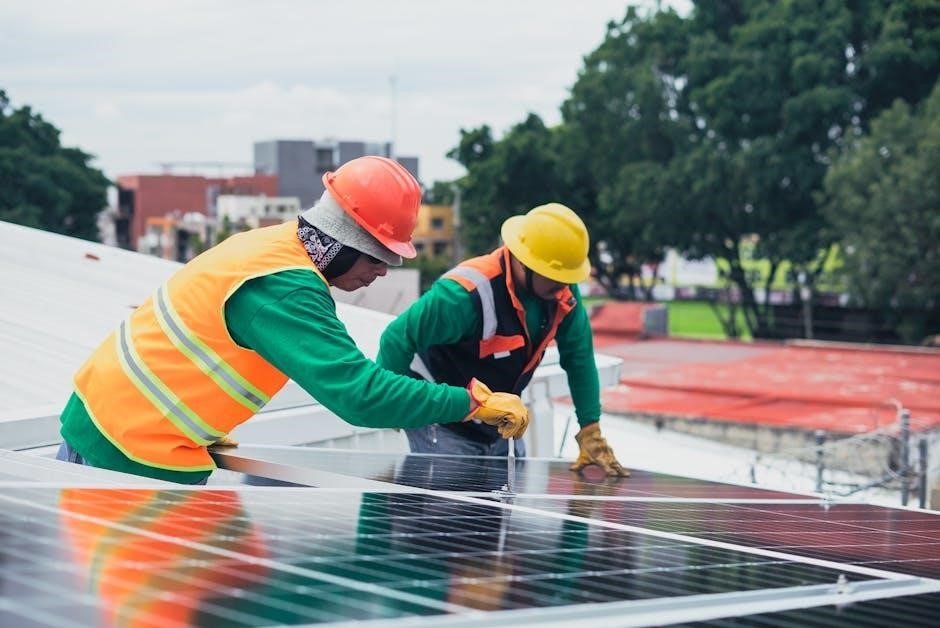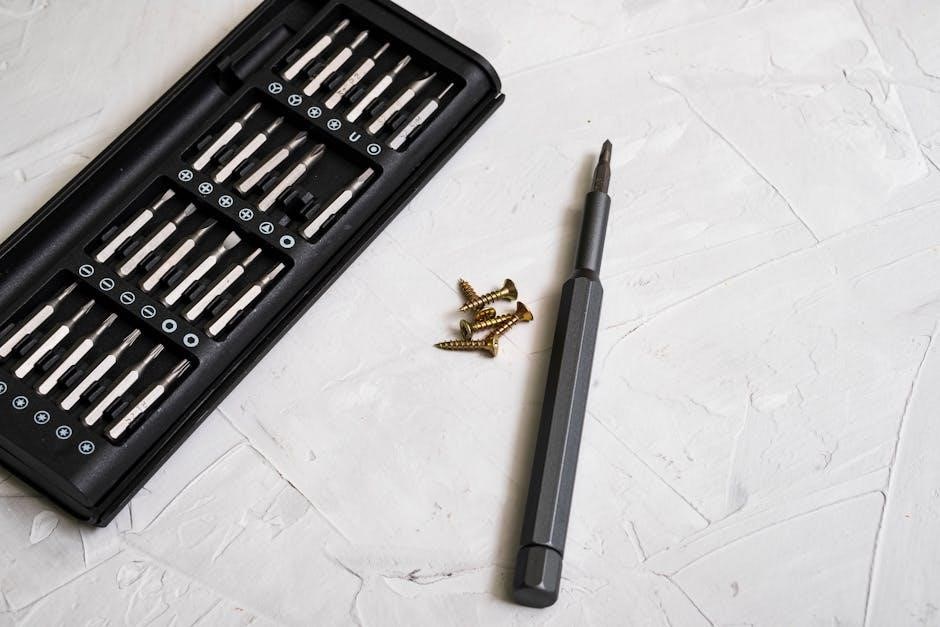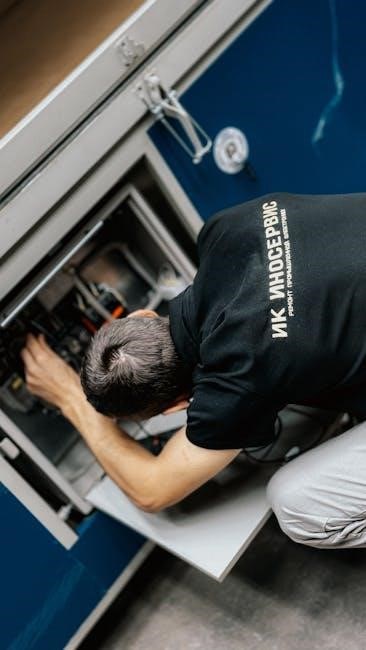
This manual provides comprehensive installation and configuration guidance for the Honeywell TH6110D1005 programmable thermostat, ensuring proper setup and optimal performance of your HVAC system.
1.1 Overview of the Thermostat
The Honeywell TH6110D1005 is a programmable, battery-powered thermostat designed for precise temperature control and energy efficiency. It belongs to the FocusPRO TH6000 series, offering a user-friendly interface and advanced features like Auto Changeover, which automatically switches between heating and cooling modes. This thermostat is compatible with various HVAC systems and provides flexible scheduling options to optimize comfort and energy savings. Its compact design and easy-to-read display make it a practical solution for residential and light commercial applications. The TH6110D1005 is known for its reliability and simplicity, making it a popular choice for homeowners seeking consistent temperature management without complex setup requirements.
1.2 Importance of Proper Installation
Proper installation of the Honeywell TH6110D1005 thermostat is crucial for ensuring optimal performance, energy efficiency, and system reliability; Incorrect installation can lead to inaccurate temperature readings, reduced system lifespan, and increased energy consumption. Following the installation manual closely ensures compatibility with your HVAC system and prevents potential safety hazards. Proper wiring and setup also guarantee that advanced features, such as Auto Changeover and programmable scheduling, function correctly. Failure to adhere to the guidelines may void the warranty or result in system malfunctions. Therefore, it is strongly recommended to have the installation performed by a trained technician to ensure compliance with safety standards and achieve the full benefits of the thermostat.


System Requirements and Compatibility
The Honeywell TH6110D1005 is compatible with low-voltage HVAC systems, including heat pumps and gas furnaces. It supports programmable scheduling and energy-saving modes, ensuring seamless integration with modern systems.
2.1 Compatible HVAC Systems
The Honeywell TH6110D1005 thermostat is designed to work seamlessly with a variety of HVAC systems, including gas furnaces, heat pumps, and air conditioning units. It is compatible with both single-stage and multi-stage systems, making it a versatile option for different home configurations. Additionally, it supports systems with auxiliary heat, ensuring reliable performance in various climates. The thermostat’s compatibility extends to traditional 24V AC systems, providing a wide range of installation possibilities. Its universal design allows it to integrate with most standard HVAC setups, ensuring efficient temperature control and energy savings. Proper installation ensures optimal performance and compatibility, making it a reliable choice for homeowners seeking precise climate management.
2.2 Technical Specifications of the TH6110D1005
The Honeywell TH6110D1005 thermostat features a 7-day programmable schedule, allowing users to customize temperature settings for different days and times. It operates on 2 AA alkaline batteries, eliminating the need for a common wire (C-wire). The thermostat supports auto changeover, automatically switching between heating and cooling modes based on the programmed settings. It is compatible with systems requiring 1- or 2-stage heating and cooling and works with both conventional and heat pump systems. The display is an easy-to-read LCD screen, and the unit is wall-mounted for convenient access. The TH6110D1005 is designed for low-voltage systems and is backed by Honeywell’s reputation for durability and reliability, ensuring long-lasting performance and energy efficiency.

Pre-Installation Steps
Before installing the Honeywell TH6110D1005, ensure you have the necessary tools, prepare the installation site, and disconnect power to the HVAC system for safety.
3.1 Tools and Materials Needed
To install the Honeywell TH6110D1005, gather the following tools and materials: a screwdriver, wire strippers, a drill (if wall anchors are needed), and a level for proper alignment. You may also require spare wires, wall anchors, and mounting screws. Ensure you have the thermostat unit, its base plate, and the installation manual. For safety, wear protective gloves and eyewear. Verify all components are included in the packaging before starting. If your HVAC system requires specific adapters or connectors, have them ready. Always refer to the manual for model-specific tools or materials. Proper preparation ensures a smooth and efficient installation process. Double-check your inventory to avoid delays.
3.2 Preparing the Site for Installation
Before installing the Honeywell TH6110D1005, ensure the installation site is properly prepared. Clear the area around the existing thermostat or mounting location of any obstructions. Inspect the wall for damage or unevenness and repair it if necessary. Ensure the area is clean and free from dust or debris. Verify that the power to the HVAC system is turned off at the circuit breaker or fuse box. If replacing an old thermostat, carefully remove it and inspect the wires for any damage or corrosion. Clean the wires with a soft cloth if needed. Plan the mounting location to ensure optimal performance, keeping it away from direct sunlight, drafts, or moisture. Proper site preparation ensures a safe and efficient installation process. Always follow safety guidelines to avoid potential hazards.
3.3 Disconnecting Power and Safety Precautions
Before starting the installation, ensure the HVAC system is powered off at the circuit breaker or fuse box. Verify the power is off using a voltage tester to avoid electrical shock. Never touch wires with wet hands or while standing on a wet surface. Avoid working in humid environments to prevent electrical hazards. Always follow local electrical codes and manufacturer guidelines for safe installation practices. Proper safety precautions protect both the installer and the equipment from potential damage. Taking these steps ensures a secure working environment and prevents accidents. Safety should never be compromised during any phase of the installation process.

Installation Process
The installation process involves mounting the thermostat, connecting wires, and finalizing setup. Ensure all steps are followed carefully to guarantee proper functionality and system efficiency.

4.1 Mounting the Thermostat
Mounting the Honeywell TH6110D1005 thermostat begins with preparing the wall. Locate the wall studs to ensure secure installation. Use a screwdriver to attach the mounting plate to the wall, ensuring it is level. If no studs are present, use wall anchors to prevent the screws from loosening over time. Once the plate is securely fastened, gently snap the thermostat onto the mounting plate until it clicks into place. Ensure the device is straight and properly aligned. If necessary, adjust the plate’s position before securing the thermostat. Double-check that all connections are tight and the thermostat is firmly attached to the wall. Proper mounting ensures accurate temperature sensing and reliable operation. Always follow safety guidelines to avoid damage or electrical issues. This step is crucial for the thermostat’s functionality and longevity.
4.2 Wiring the Thermostat
Wiring the Honeywell TH6110D1005 thermostat requires careful attention to ensure proper functionality. Begin by identifying the correct wires from your HVAC system, such as R (24V power), W (heating), Y (cooling), G (fan), C (common), and any additional wires for advanced features. Shut off the power supply to the HVAC system before proceeding to avoid electrical hazards. Connect each wire to the corresponding terminal on the thermostat, ensuring secure and tight connections. Refer to the wiring diagram in the manual to match the wires correctly, especially for heat pumps or two-stage systems. After wiring, turn the power back on and test the thermostat by switching between heating and cooling modes to verify proper operation. Correct wiring is essential for the thermostat to control your HVAC system effectively and safely.
4.3 Finalizing the Installation
After completing the wiring and mounting, the final steps ensure the thermostat operates smoothly. Turn the power back on at the circuit breaker and test the thermostat by adjusting the temperature settings. Verify that the HVAC system responds correctly to heating and cooling commands. Check for any air leaks around the thermostat mounting area and seal them if necessary. Program the thermostat with your preferred schedule and temperature settings, ensuring it aligns with your daily routines. Finally, perform a full system test by running through all operating modes to confirm everything functions as expected. Dispose of any packaging materials responsibly and store the installation manual for future reference. Proper finalization ensures reliable performance and energy efficiency.

Configuration and Setup
Power on the thermostat and navigate through the menu to select your HVAC system type and preferred settings. Configure basic functions like temperature range and scheduling options.
5.1 Initial System Setup
After installation, power on the thermostat and follow the on-screen prompts to complete the initial setup. Select your HVAC system type (heat, cool, or both) and configure basic settings like temperature range and unit of measurement. Choose your preferred language and date/time format. Set the clock manually or enable automatic time syncing. Define temperature limits to ensure safe operation and energy efficiency. Check the screen for any firmware updates and install them if available. Familiarize yourself with the menu navigation and ensure all wired connections are secure. Test the display responsiveness and backlight settings for optimal visibility. Review the default settings and adjust as needed to match your comfort preferences and energy-saving goals. Save your configurations to finalize the setup process.
5.2 Programming the Thermostat
Programming the Honeywell TH6110D1005 allows you to create a customized schedule tailored to your daily routine. Use the touchscreen interface to set temperature preferences for different times of the day and week. Select from pre-set templates or customize each day individually. Set heating and cooling temperature points, ensuring energy efficiency and comfort. Choose between energy-saving modes or continuous operation based on your needs. Enable features like hold or vacation mode to override schedules temporarily. Adjust the program to account for weekends or holidays if needed. Save your programmed settings to ensure consistent operation. Review and test your schedule to confirm it aligns with your lifestyle and energy goals. Regularly update your program if your schedule changes to maintain optimal performance and efficiency.
5.3 Testing the System
After installation and configuration, thoroughly test the Honeywell TH6110D1005 to ensure proper functionality. Start by verifying basic operations, such as turning the system on/off and adjusting temperature settings. Check that the thermostat accurately reflects the system’s status and responds to input. Test heating and cooling modes to confirm smooth transitions. Verify that programmed schedules activate correctly at set times. Inspect wiring connections to ensure no loose links or short circuits. Use the touchscreen to simulate extreme temperatures and observe the system’s response. Test any advanced features, such as smart home integration or energy-saving modes, to ensure compatibility. Review the system’s performance over a full cycle to identify any discrepancies. Address any issues promptly to ensure reliable operation and optimal comfort.

Advanced Features and Settings
The Honeywell TH6110D1005 offers advanced features like auto changeover, smart home integration, and energy-saving modes. These settings optimize performance and enhance user convenience for tailored comfort.
6.1 Understanding Auto Changeover
The Honeywell TH6110D1005 features an Auto Changeover function, which automatically switches between heating and cooling modes based on the temperature setpoint and ambient conditions. This feature ensures seamless transitions, maintaining consistent comfort levels without manual intervention. It is particularly useful in climates with fluctuating temperatures, allowing the system to adapt efficiently. To enable Auto Changeover, navigate to the thermostat’s settings menu and select the option. Proper configuration is essential for optimal performance. This advanced feature enhances energy efficiency and user convenience, making it a standout capability of the TH6110D1005 thermostat.
6.2 Configuring Smart Home Integration
Configuring smart home integration for the Honeywell TH6110D1005 allows seamless control through popular platforms like Amazon Alexa or Google Home. Start by ensuring your thermostat is connected to Wi-Fi and that your smart home hub is compatible. Open the Honeywell Home app and navigate to the settings menu. Select the option for smart home integration and follow the prompts to link your accounts. Once connected, you can control your thermostat using voice commands or through the smart home app. This feature enhances convenience and enables advanced automation options. Ensure your system is updated to the latest firmware for optimal performance. Proper configuration ensures smooth integration and maximizes smart home benefits.

Troubleshooting Common Issues
Troubleshooting common issues with the Honeywell TH6110D1005 involves identifying symptoms, checking wiring connections, and resetting the system. Refer to the manual for detailed diagnostic steps.
- Check for loose connections or damaged wires.
- Restart the thermostat and HVAC system.
- Ensure proper power supply and battery levels.
7.1 Common Installation Mistakes
Common installation mistakes with the Honeywell TH6110D1005 include incorrect wiring connections, failure to level the thermostat, and improper system configuration. Ensure all wires match the correct terminals and double-check the manual for compatibility. Ignoring safety precautions, such as not turning off power, can lead to damage or injury. Mounting the thermostat unevenly may affect temperature accuracy. Forgetting to program the system type (e.g., heat pump, gas furnace) can result in poor performance. Additionally, rushing through the installation without verifying each step increases the likelihood of errors. Always refer to the manual for specific guidelines to avoid these pitfalls and ensure a smooth setup process.
7.2 Diagnosing and Resolving Errors
Diagnosing and resolving errors with the Honeywell TH6110D1005 involves identifying the root cause of the issue. Start by checking the error codes displayed on the thermostat, as they often indicate specific problems like faulty wiring or system malfunctions. Verify all connections to ensure they are secure and correctly matched to their terminals. If the thermostat fails to power on, check the circuit breaker or fuse. For temperature inaccuracies, ensure the thermostat is properly leveled and installed away from direct sunlight or drafts. Consult the manual for troubleshooting guides specific to the error code. If issues persist, reset the thermostat to factory settings or contact a professional for assistance. Regular maintenance and updates can also prevent recurring errors.

Maintenance and Upkeep
Regular maintenance ensures optimal performance. Clean the thermostat to prevent dust buildup, check for software updates, and verify proper installation and connections to avoid operational issues and errors.
8.1 Routine Maintenance Tips
Regular maintenance is crucial for ensuring the Honeywell TH6110D1005 thermostat operates efficiently. Dust the thermostat faceplate and internal components periodically to prevent interference with temperature sensors. Check for firmware updates to maintain optimal functionality and security. Inspect wiring connections to ensure they are secure and free from damage. Verify that the thermostat is properly calibrated to avoid temperature inaccuracies. Clean the screen gently with a soft cloth to maintain visibility. Additionally, review the system settings periodically to ensure they align with your preferences. By following these routine maintenance tips, you can extend the lifespan of your thermostat and ensure reliable performance year-round.
8.2 Battery Replacement and Care
The Honeywell TH6110D1005 thermostat is powered by AA alkaline batteries, ensuring reliable operation even during power outages. To replace the batteries, turn off the system at the circuit breaker and remove the thermostat faceplate. Gently pull out the battery holder and replace the old batteries with new ones, ensuring the polarity matches the diagram. Avoid mixing old and new batteries or using different types. Check battery levels regularly, as low batteries may cause erratic behavior. Replace batteries every 12-24 months or when the low-battery indicator appears. Store spare batteries in a cool, dry place, away from children. Proper battery care ensures consistent performance and extends the lifespan of your thermostat.
By following the Honeywell TH6110D1005 installation manual, you ensure a successful setup, optimizing system efficiency and reliability. Proper installation and maintenance guarantee optimal performance and energy savings.
9.1 Final Checks and Verification
After completing the installation, perform a thorough system check to ensure everything functions correctly. Verify that all wiring connections are secure and match the manual’s guidelines. Turn on the power supply and test the thermostat’s basic operations, such as switching between heating and cooling modes. Check the display for clarity and responsiveness. Ensure the schedule is programmed and that smart home integrations (if applicable) are functioning properly. Review the installation manual one last time to confirm no steps were missed. Finally, test the system under various conditions to ensure smooth operation. These checks are crucial for optimal performance and energy efficiency.
9.2 Ensuring Optimal Performance
To ensure the Honeywell TH6110D1005 operates at its best, maintain regular maintenance routines and adhere to best practices. Clean the thermostat’s display and sensors periodically to prevent dust buildup, which can affect accuracy. Check for firmware updates and install them as needed to access the latest features and improvements. Program schedules that align with your lifestyle to maximize energy savings without compromising comfort. Adjust temperature settings carefully, avoiding extreme changes that could strain the HVAC system. Educate all users on proper operation to prevent misuse. By following these steps, you can ensure the thermostat performs efficiently, providing consistent comfort and energy efficiency over time.